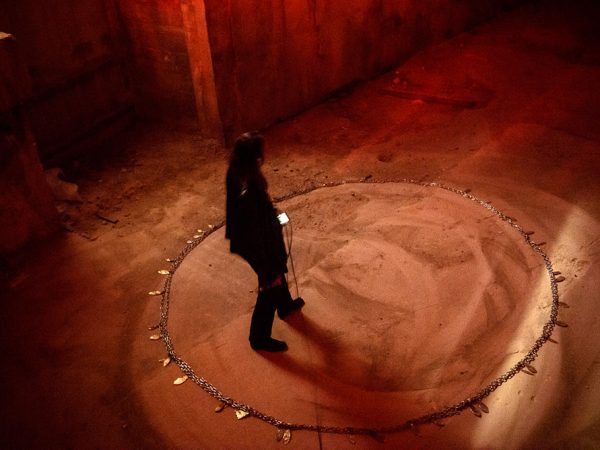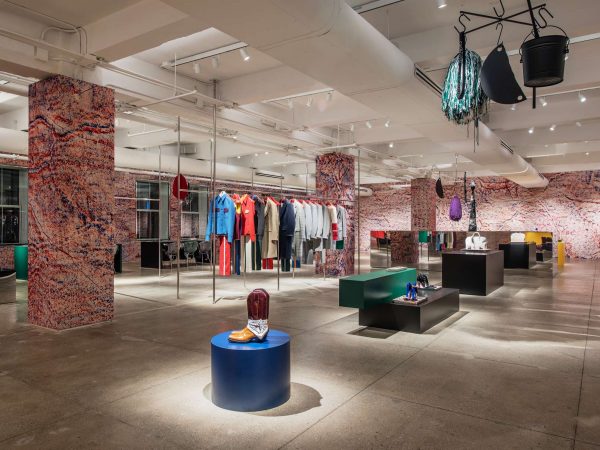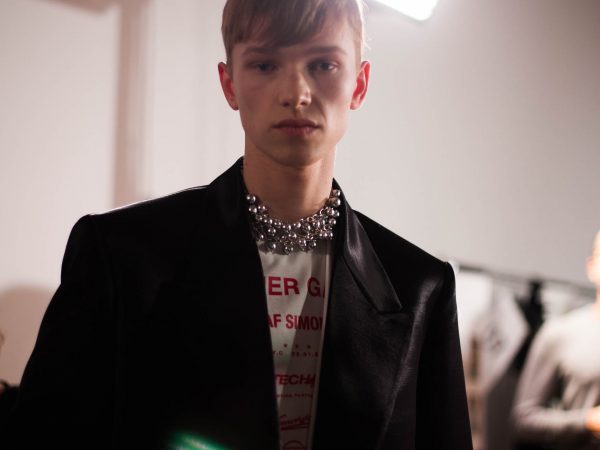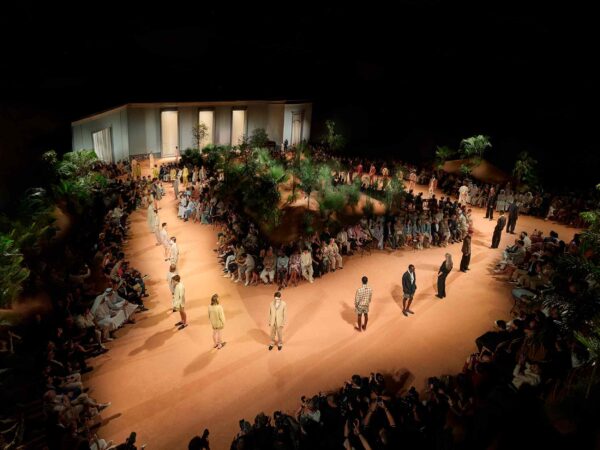In the era of minimalism and Marie Kondo, we’re made to feel bad about not wanting to give items up. Janelle Abbott's 'Wardrobe Therapy' makes sentimental attachment something to be proud of.
My emotions have always been closely linked to my wardrobe, and it’s always been difficult to rid my closet of the vintage clothes, mementos, and stuff I’ve acquired throughout the years. The process of decluttering feels totally overwhelming, while I also have a hard time deciding what to keep, sell, or donate. So how do you let go of garments that feel like old friends? And why do we let our wardrobes fill up with items we appreciate but never seem to wear? These are just two questions Janelle Abbott, Seattle-based artist and co-founder of zero-waste fashion brand Femail, is attempting to answer through her new conceptual art project Wardrobe Therapy.
To start, Abbott–who grew up playing with textiles and learned how to sew at a young age since her parents ran a clothing manufacturing company–first initiates a dialogue with her client in the midst of their wardrobe, dissecting where their fashion sense began, where it’s landed now, and how they might see it manifesting in the future. From there, she sorts through their closet and stuff, working with the person to extract items that no longer fit physically, no longer fit their style, or have sentimental value but simply are no longer in rotation. Lastly, Abbott then turns the selected items into one-of-a-kind pieces by deconstructing and reconstructing what once was forgotten into something new and original.
Recently, I had the pleasure of participating in Abbott’s new project, and came out of it with a deeper sense of self—and, of course, a set of cool new (old) wares. Here, we speak about how Wardobe Therapy is helping people reconcile with their past fashion choices, their body image, and their personal identity.
Above The Fold

Sam Contis Studies Male Seclusion

Slava Mogutin: “I Transgress, Therefore I Am”

The Present Past: Backstage New York Fashion Week Men’s Spring/Summer 2018

Pierre Bergé Has Died At 86

Falls the Shadow: Maria Grazia Chiuri Designs for Works & Process

An Olfactory Memory Inspires Jason Wu’s First Fragrance

Brave New Wonders: A Preview of the Inaugural Edition of “Close”

Georgia Hilmer’s Fashion Month, Part One

Modelogue: Georgia Hilmer’s Fashion Month, Part Two

Surf League by Thom Browne

Nick Hornby: Grand Narratives and Little Anecdotes

The New Helmut

Designer Turned Artist Jean-Charles de Castelbajac is the Pope of Pop

Splendid Reverie: Backstage Paris Haute Couture Fall/Winter 2017

Tom Burr Cultivates Space at Marcel Breuer’s Pirelli Tire Building

Ludovic de Saint Sernin Debuts Eponymous Collection in Paris

Peaceful Sedition: Backstage Paris Fashion Week Men’s Spring/Summer 2018

Ephemeral Relief: Backstage Milan Fashion Week Men’s Spring/Summer 2018

Olivier Saillard Challenges the Concept of a Museum

“Not Yours”: A New Film by Document and Diane Russo

Introducing: Kozaburo, 2017 LVMH Prize Finalist

Introducing: Marine Serre, 2017 LVMH Prize Finalist

Conscious Skin

Escapism Revived: Backstage London Fashion Week Men’s Spring/Summer 2018

Introducing: Cecilie Bahnsen, 2017 LVMH Prize Finalist

Introducing: Ambush, 2017 LVMH Prize Finalist

New Artifacts

Introducing: Nabil Nayal, 2017 LVMH Prize Finalist

Bringing the House Down

Introducing: Molly Goddard, 2017 LVMH Prize Finalist

Introducing: Atlein, 2017 LVMH Prize Finalist

Introducing: Jahnkoy, 2017 LVMH Prize Finalist

LVMH’s Final Eight

Escaping Reality: A Tour Through the 57th Venice Biennale with Patrik Ervell

Adorned and Subverted: Backstage MB Fashion Week Tbilisi Autumn/Winter 2017

The Geometry of Sound

Klaus Biesenbach Uncovers Papo Colo’s Artistic Legacy in Puerto Rico’s Rainforest

Westward Bound: Backstage Dior Resort 2018

Artist Francesco Vezzoli Uncovers the Radical Images of Lisetta Carmi with MoMA’s Roxana Marcoci

A Weekend in Berlin

Centered Rhyme by Elaine Lustig Cohen and Hermès

How to Proceed: “fashion after Fashion”

Robin Broadbent’s Inanimate Portraits

“Speak Easy”

Revelations of Truth

Re-Realizing the American Dream

Tomihiro Kono’s Hair Sculpting Process

The Art of Craft in the 21st Century

Strength and Rebellion: Backstage Seoul Fashion Week Autumn/Winter 2017

Decorative Growth

The Faces of London

Document Turns Five

Synthesized Chaos: “Scholomance” by Nico Vascellari

A Whole New World for Janette Beckman

New Ceremony: Backstage Paris Fashion Week Autumn/Winter 2017

New Perspectives on an American Classic

Realized Attraction: Backstage Milan Fashion Week Autumn/Winter 2017

Dematerialization: “Escape Attempts” at Shulamit Nazarian

“XOXO” by Jesse Mockrin

Brilliant Light: Backstage London Fashion Week Autumn/Winter 2017

The Form Challenged: Backstage New York Fashion Week Autumn/Winter 2017

Art for Tomorrow: Istanbul’74 Crafts Postcards for Project Lift

Inspiration & Progress

Paskal’s Theory of Design

On the Road

In Taiwan, American Designer Daniel DuGoff Finds Revelation

The Kit To Fixing Fashion

The Game Has Changed: Backstage New York Fashion Week Men’s Autumn/Winter 2017

Class is in Session: Andres Serrano at The School

Forma Originale: Burberry Previews February 2017

“Theoria”

Wearing Wanderlust: Waris Ahluwalia x The Kooples

Approaching Splendor: Backstage Paris Haute Couture Spring/Summer 2017

In Florence, History Returns Onstage

An Island Aesthetic: Loewe Travels to Ibiza

Wilfried Lantoine Takes His Collection to the Dancefloor

A Return To Form: Backstage New York Fashion Week Spring/Summer 2018

20 Years of Jeremy Scott

Offline in Cuba

Distortion of the Everyday at Faustine Steinmetz

Archetypes Redefined: Backstage London Fashion Week Spring/Summer 2018

Spring/Summer 2018 Through the Lens of Designer Erdem Moralıoğlu

A Week of Icons: Backstage Milan Fashion Week Spring/Summer 2018

Toasting the New Edition of Document

Embodying Rick Owens

Prada Channels the Wonder Women Illustrators of the 1940s

Andre Walker’s Collection 30 Years in the Making

Fallen From Grace, An Exclusive Look at Item Idem’s “NUII”

Breaking the System: Backstage Paris Fashion Week Men’s Autumn/Winter 2017

A Modern Manufactory at Mykita Studio

A Wanted Gleam: Backstage Milan Fashion Week Men’s Autumn/Winter 2017

Fashion’s Next, Cottweiler and Gabriela Hearst Take International Woolmark Prize

Beauty in Disorder: Backstage London Fashion Week Men’s Autumn/Winter 2017

“Dior by Mats Gustafson”

Prada’s Power

George Michael’s Epochal Supermodel Lip Sync

The Search for the Spirit of Miss General Idea

A Trace of the Real

Wear and Sniff

Underwater, Doug Aitken Returns to the Real
Sara Radin—What’s the main focus of your work?
Janelle Abbott—I create clothing and art on my own under the name JRAT, which is activity that I engage in when I have a collection of materials and a concept that I want to execute. Then, I work with my friend Camilla Carper on a collaboration called FEMAIL. Camilla lives in Los Angeles and we’ve been working together for about six years, just sending clothing and art back and forth and bringing them to life together.
Sara—Talk to me a bit more about your passion for zero waste fashion and upcycling.
Janelle—I studied under Timo Rissanen at Parsons New School of Design. He and Holly Mcquillan are at the forefront of the zero waste fashion movement as far as the philosophical side of it goes. During my junior year, I realized I liked the idea of designing patterns that dictated the aesthetic of the garment. It’s like creating a giant puzzle that is then deconstructed and created into a garment, and then later that garment can be deconstructed and returned to a perfect square or rectangle of fabric. But also, I care about the global impact of the fashion industry and want to improve the overall function.
Sara—And what about upcycling?
Janelle—With upcycling, it’s all about how to salvage precious garments and breathe new life into them. The older I get the more cautious I am about allowing things into my experience. I want to be responsible for the things in my possession. There’s an overwhelming amount of material in the world but upcycling has been a therapeutic way of coming to terms with that. With all things in design, it’s about puzzles, whether it’s the puzzle of reconstructing an old garment and using all of its pieces to make something new, or it’s the puzzle of turning a square or rectangle into a garment without losing a single scrap.
“The older I get the more cautious I am about allowing things into my experience. I want to be responsible for the things in my possession.”
Sara—How did Wardrobe Therapy come about?
Janelle—Camilla and I designed a workshop that involved people cutting up a garment they had an emotional connection with—something they were holding onto, but had stopped wearing. Everyone talked about their garments and then cut off a piece they didn’t like. Others took those pieces and used them to integrate them into a garment they created out of the piece salvaged from their own material. So everyone’s garments just got swirled together.
Sara—I love that. What did that process represent for you?
Janelle—It was a way of reconciling with the way our body image has been tainted by the power of the fashion industry, and gives us a way to take ownership over our things, and use all of that to create a new idea of ourselves—a more realistic vision and a more loving vision of who we are as individuals. I really liked that concept and I decided I would try it out as a service, where I work with people one on one.
“I’ve just found it really enjoyable talking to people about how their relationship with their clothing has evolved through their lives.”
Sara—What interests you most about this new project?
Janelle—I like going to people’s houses, talking with them about fashion, and how they relate to it. I like helping them change their point of view on their wardrobe and see spaces where they’re allowing things to clutter up that don’t belong anymore. Or that they’re holding onto things that are sentimental, which could become newly envisioned garments. It can be kind of a challenge to figure out how to mash a variety of disparate pieces together. But I’ve just found it really enjoyable talking to people about how their relationship with their clothing has evolved through their lives, and helping them figure out what they have and how they can be a little more cognizant of the way that they shop.
Sara—It felt really emotional for me to participate. I was nervous to let go of my clothes and see how the updated garments would turn out. But at the same time, I was super excited. What have you learned about yourself and your process through these intimate experiences?
Janelle—I’ve been really humbled by the way people have opened up to me. It’s an honor to make space for them to say things they’ve never said about themselves and their relationship to their clothes. Each session has been really different and I feel like I have a heightened level of responsibility to preserve what it is someone has articulated that they want out of their garments. Working with you, there were certain elements of the garments that needed to be retained and preserved but there were other pieces that were a little more up for debate.
I realized I can help people by just being present to listen. I feel an equal sense of empowerment from the way that others have felt empowered by this process.



















